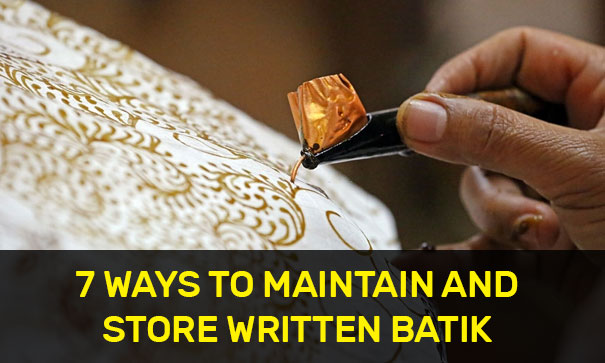Written batik is a type of batik whose value is relatively expensive. The price range for written batik in Indonesia ranges from hundreds of thousands, to tens or even hundreds of millions of rupiah per piece. This is due to many factors such as the process factor, the time factor for the process, historical factors, and the age of the batik. The age of a piece of written batik can reach up to hundreds of years, depending on how the owner keeps and keeps the written batik.
In fact, maintaining a piece of batik cloth is not easy. Lots of tips and tricks to protect it, so that it doesn’t tear quickly, doesn’t have holes eaten by moths, and the color doesn’t fade easily.
Here are 7 tips and tricks for maintaining and storing written batik properly.
1. Hand Wash Not Machine Washing
Written batik cloth is not the same as washing cloth or other clothes. If washing clothes can be done easily in the washing machine, then this is something that is not recommended in caring for hand-written batik cloth. There was no washing machine in ancient times, so our ancestors washed batik cloth manually by hand.
But the most basic reason is that twisting or stirring it in the washing machine pulls the fibers of the fabric and causes it to wrinkle. Also, when washing by hand, try not to use a brush. This is so that the color does not fade or fade quickly.
2. Wash With Special Batik Soap
Washing written batik is also not possible with ordinary laundry soap or detergent. Scientifically and in clinical trials, the chemical content in detergents can damage fabrics and colors on batik fabrics. This is due to the harsh chemical fibers of detergents to remove stains.
In ancient times, our ancestors used a soap made from lerak seeds. Lerak seeds were first discovered in India and Nepal, where people were originally used there to treat eczema and psoriasis. The lerak seed is a plant husk or shell on the fruit harvested from sapindus mukorossi, a tree native to warm, rainy climates like a typical southern Asian country.
Lerak seeds are well known as traditional detergents because they contain saponins, a toxic alkaloid that produces foam and saponins work as a surfactant that can remove stains, oil and dirt. Besides lerak seeds, washing hand-written batik can also be done easily using shampoo for hair.
3. Rubbed not Squeezed
Washing written batik should be like treating a girl, in a gentle way without violence. Wash the batik cloth only by hand, and only need to be rubbed briefly without having to be squeezed to dry the water that is still on the fibers of the written batik cloth itself. Squeezing batik cloth can cause wrinkled and damaged fabric fibers.
4. Wind Dry
When the hand-written batik has been washed, then after that, dry the batik cloth only by aerating it, without drying it directly in the sun or putting it in an automatic drying machine. Drying in the sun directly causes the color of the batik to fade quickly. And putting batik in an automatic dryer can cause the material to shrink or shrink, because the heat is different.
5. Coated Fabric When Ironed
When you want to iron the batik cloth with an electric or steam iron, it is advisable to coat the batik cloth with a thin sheet of cloth over the surface of the batik. This is done in order to avoid the cloth with excessive heat exposure from the iron. This is the traditional way that our ancestors did from time immemorial.
6. It is advisable not to use fragrances or perfumes
Clothes deodorizers, whether iron or body fragrances (perfume) are harsh chemical compounds when exposed directly to hand-written batik cloth or hand-written batik shirts. So it is recommended not to use both, because once sprayed, it tends to leave stains that are difficult to wash or remove.
7. Save With Special Treatment
Storing written batik must be treated with a special. Store batik cloth in the cupboard with dry temperature, but not in a damp cupboard. When stored in a humid area, it will attract animals such as moths to come and gnaw at the batik cloth which can cause the batik to be hollow.
Another way is to store it covered with cloth or paper one by one. Or when stored in a cupboard or in a suitcase, don’t forget to add a little pepper or vetiver. The two plants are enemies of the moth which they dislike. The temperature must also be regulated, at least below 25 degrees Celsius.


